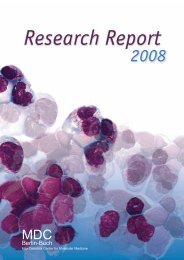Create successful ePaper yourself
Turn your PDF publications into a flip-book with our unique Google optimized e-Paper software.
Role of lysosphingophospholipid<br />
receptors in the immune system<br />
We have cloned human EDG6 from in<br />
vitro differentiated dendritic cells in<br />
order to identify novel G proteincoupled<br />
receptors (GPCR) that control<br />
immune functions. EDG6-specific<br />
RNA was detected almost exclusively<br />
in lymphoid and hematopoietic tissue,<br />
and in lung. Moreover the expression<br />
pattern of EDG6 was found to be<br />
conserved in mouse and man.<br />
Homology of EDG-6 to the recently<br />
identified sphingosine-1-phosphate<br />
(SPP) receptors EDG-1, -3 and -5 and<br />
lysophosphatidic acid (LPA) receptors<br />
EDG-2 and -4. suggests that its ligand<br />
may be a lysophospholipid or<br />
lysosphingolipid. In collaboration<br />
with S. Spiegel, Washington, we have<br />
shown that EDG-6 is a high affinity<br />
receptor for SPP which couples to a<br />
G i/o protein resulting in the activation<br />
of growth-related signaling pathways.<br />
Although the biological significance<br />
of SPP signaling via EDG-6 in<br />
lymphocytes and dendritic cells is<br />
70<br />
Spleen<br />
PP<br />
LN ?<br />
maturation<br />
& migration<br />
CXCR5<br />
iDC<br />
ELC<br />
CXCR5<br />
B<br />
B<br />
(skin)<br />
immature antigencapturing<br />
LC<br />
DC<br />
T<br />
CCR7<br />
T<br />
T T T<br />
B B<br />
LTα1β2 LTβR<br />
CCR7<br />
CCR7<br />
poorly understood, the well<br />
characterized growth-related or<br />
cytoskeleton-associated activities of<br />
SPP suggest that members of the EDG<br />
family may synergize with signaling<br />
pathways initiated by cytokines.<br />
Lysosphingophospholipids may play a<br />
critical role as potent autocrine and<br />
paracrine mediators in specific microenvironmental<br />
settings of normal and<br />
pathophysiological immune responses.<br />
Differentiation-specific<br />
regulation and function of<br />
CD155/poliovirus receptor<br />
CD155, a transmembrane protein<br />
possessing an Ig-like architecture, was<br />
discovered originally by its ability to<br />
serve as the cellular receptor for<br />
poliovirus (PV). Since then, a lot of<br />
effort has been devoted to elucidate<br />
the involvement of CD155 in PV<br />
infection, a complicated series of<br />
events with the potential outcome of<br />
the poliomyelits syndrome in affected<br />
individuals. However, there is no<br />
CCR7<br />
afferent<br />
lymphatic vessels<br />
CXCR5<br />
B<br />
FDC<br />
HEV<br />
SLC<br />
SLC<br />
peripheral<br />
tissue<br />
B<br />
BLC<br />
stromal<br />
cells<br />
T<br />
T<br />
stromal<br />
cells<br />
CCR7<br />
T<br />
efferent<br />
lymphatic vessels<br />
B zone<br />
T<br />
information about the natural function<br />
of CD155 and, so, we initiated studies<br />
I) to investigate the expression profile<br />
of CD155 (by means of analysing the<br />
promoter of the CD155 gene) and II)<br />
to identify counter receptors/ligands<br />
of CD155. Our findings suggest that<br />
CD155 is one of the cell adhesion<br />
class of molecules since it interacts<br />
with vitronectin and, to a lesser<br />
extent, with fibronectin. Currently, we<br />
are investigating these interactions in<br />
more detail. Interestingly,<br />
immunohistochemical studies have<br />
shown that expression of vitronectin<br />
and CD155 colocalizes to the<br />
germinal centers of secondary<br />
lymphoid tissue.<br />
Figure 28: Lessons from chemokine receptor<br />
knock outs: Model of chemokine-directed<br />
trafficking of lymphocytes and dendritic cells to<br />
and through secondary lymphoidorgans during<br />
the immune response.

















